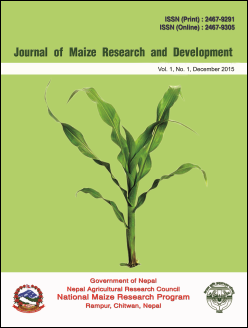Simulation of growth and yield of rainfed maize under varied agronomic management and changing climatic scenario in Nawalparasi, Nepal
DOI:
https://doi.org/10.3126/jmrd.v1i1.14250Keywords:
Spring maize, Sowing dates, Cultivars, Grain yield, CSM_CERES-Maize model, Climate ChangeAbstract
Correction: Figure 3 was corrupted and so the PDF was replaced on 29th December 2016 with the corrected Figure 3.
A field experiment and simulation modeling study in combination for different maize cultivars planted at different sowing dates were accomplished at Kawasoti-5, Nawalparasi during spring season of 2013 to assess the impact of climate change scenario as predicted by IPCC in rainfed spring maize by using CSM-CERES-Maize model. Result showed that RML-4/RML-17 produced higher kernel rows/ ear (13.77), kernel per row (30.42) and test weight (244.9 g). Significantly higher grain yield was also found for RML-4/RML-17 (6.03 t/ha) compared to Poshilo makai-1 (4.73 t/ha), Arun-2 (3.55 t/ha) and Local (2.92 t/ha). Earlier sowing date (7th April) actually produced higher kernel/row (27.97), kernel rows/ear (12.89) and 1000 grain weight (230 g). Significantly higher grain yield (5.13t/ha) was obtained in earlier sowing date (7th April). The CSM-CERES-Maize model was calibrated and found well validated with days to anthesis (RMSE= 0.426 day and D-index= 0.998), days to physiological maturity (RMSE=0.674 day and D-index= 0.999), number of grain/m2 at maturity (RMSE= 85.287 grain /m2 and D-index= 0.993), unit weight at maturity (RMSE=0.012 g/kernel and D-index= 0.854) and grain yield (RMSE=54.94 kg/ha and D-index= 1.00). The model was found sensitive to climate change parameters. The sensitivity for various climate change parameter indicated that there was severely decreased trend in simulated rainfed spring maize yield with the increment of maximum and minimum temperature, decrease in solar radiation and decrease carbondioxide concentration. Even 2°C rise in temperature can decrease around 15-20% yield of spring maize and this negative effect was even more pronounced in hybrid than other cultivars.
Journal of Maize Research and Development (2015) 1(1):123-133




